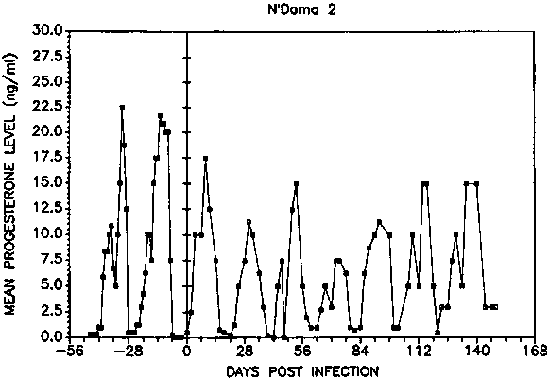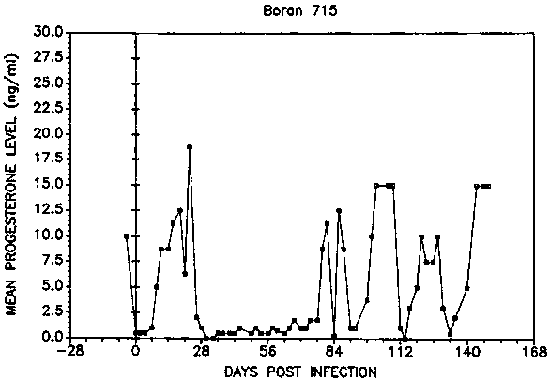E. LORENZINI, J.R. SCOTT, R.W. PALING and T. JORDT
Introduction
Materials and methods
Results
Discussion
References
Trypanotolerance, as a characteristic in certain breeds of cattle, continues to generate considerable interest as a means of combating the effects of trypanosomiasis in Africa (Murray et al., 1984). One cattle breed in particular, the N'Dama of West Africa (Bos taurus), shows a high degree of trypanotolerance (Murray et al., 1982) which is expressed by its ability to control the number of trypanosomes in circulation and the resultant anaemia better than the more susceptible breeds. Thus the N'Dama is able to sustain a level of productivity in circumstances under which the susceptible Boran (B. indicus) cattle would die (Murray et al., 1981). The factors associated with this tolerance are currently under investigation at ILRAD. Research on the effect of trypanosomiasis on fertility in Boran cows has demonstrated conclusively its negative effect on both ovarian activity and on established pregnancy (Llewelyn et al., 1987; Ogwu et al., 1984; Ogwu et al., 1985), while other reports have shown that the semen quality in Boran bulls infected with trypanosomiasis is negatively affected, (Grundler and Djabakou, 1985).
The purpose of this experiment, which was part of an ongoing series of experiments comparing N'Dama and Boran cattle, was to observe the effects of Trypanosoma congolense infection on the growth, regression and function of the luteal tissue during the oestrus cycle of the trypanotolerant N'Dama.
Experimental animals
Five N'Dama heifers, which were part of the group of N'Dama cattle brought to Kenya by embryo transfer from The Gambia (Jordt et al., 1986) and nine Boran heifers, from Kapiti Plains estate, Kenya, were used. All cattle were two years of age at the start of the experiment and had been reared in an area of Kenya free from trypanosomiasis. The N'Damas and five of the Boran had previously been infected on two separate occasions with different serodemes of T. congolense (Paling et al., in preparation; Ellis et al., in press). In these previous experiments the majority of the Boran heifers had required treatment when their PCV reached 15%, whereas the N'Damas required no treatment since their PCV showed an insignificant and transient drop. At the termination of each of these experiments, all cattle were treated with diminazene aceturate (Berenil, Hoechst). The results, recorded in this paper represent the third challenge for these animals and a new group of four age-matched naive Boran heifers was included. One naive Boran heifer continued to act as a control.
Each animal was infected with T. congolense serodeme IL 1587 (swinger, 1986) transmitted by Glossina morsitans centralis and the infections were terminated by treatment with Berenil (7 mg/kg) after 149 days or when individual animal PCV levels reached 15%.
Kamar heat mount detectors (Kamar Inc., Steamboat Springs, Colorado) were employed to help detecting commencement of oestrous behaviour in the N'Dama heifers and were used during the 45-day pre-infection period.
Progesterone sampling and analysis
For a period of 45 days prior to infection, the N'Dama were bled daily while after infection all animals were bled three times a week until the end of the experiment. All blood samples were collected in 10 ml vacutainer tubes coated with EDTA and, after separation, the plasma samples were stored at -20°C. Plasma progesterone was estimated using a commercially available enzyme-amplified immunoassay (AELIA) kit (Enzygnost, Hoechst) with a total of 34 kits being used. Each of the kits was supplied with standards containing 0, 1, 5, 10 and 30 ng progesterone/ml, but a 15 ng/ml standard was produced and added to the test in order to satisfactorily cover the range. All the samples were tested at least in duplicate and were carried out according to the manufacturer's instructions. Colour intensity in each well was estimated both visually and using a MICROELISA auto reader at 492 nm. (DynatecMR 580).
Plasma progesterone measurements were made on 45 cycles in total for the five N'Damas, each of which had completed at least two oestrus cycles prior to infection with T. congolense. They continued to cycle throughout the infection period, completing at least six oestrus cycles, during which trypanosomes were consistently detectable in the blood. Furthermore, none of the N'Dama showed impaired luteal function at any time during the experiment.
The average oestrous cycle length for the N'Dama was 20.34 (s.d. 2.16) days with the average luteal phase being 12.42 (s.d. 2.40) days and the follicular phase lasting 7.79 (s.d. 2.17) days (see Table 1). Of the 45 cycles examined the minimum oestrous cycle length was 15.5 days and the maximum was 25.5 days.
Figure 1. Progesterone profile of a N'Dama heifer.

Comparison of the profiles before and after infection indicated no apparent difference in either the average duration of the oestrous cycles or the progesterone levels in these animals. Figure 1 shows a typical progesterone profile of one of the N'Dama heifers.
Table 1. Length of oestrous cycle and the luteal and follicular phases of N'Dama and Boran heifers.
|
|
Period |
Luteal |
Follicular phase |
||||
|
Mean |
s.d. |
Mean |
s.d. |
Mean |
s.d. |
||
|
N'Dama 1 |
19.39 |
1.93 |
11.33 |
2.24 |
7.90 |
2.56 |
|
|
N'Dama 2 |
21.19 |
1.79 |
12.25 |
2.60 |
8.56 |
3.00 |
|
|
N'Dama 3 |
21.75 |
2.02 |
13.50 |
2.39 |
8.00 |
2.06 |
|
|
N'Dama 4 |
20.28 |
2.21 |
13.33 |
2.65 |
6.90 |
1.37 |
|
|
N'Dama 5 |
19.50 |
2.14 |
11.88 |
1.86 |
7.44 |
1.71 |
|
|
Overall |
20.34 |
2.16 |
12.42 |
2.40 |
7.79 |
2.17 |
|
|
Boran |
|||||||
|
|
C715 |
20.50 |
0.71 |
12.00 |
1.41 |
8.67 |
1.51 |
|
|
C727 |
18.50 |
1.87 |
7.00 |
2.16 |
11.60 |
0.55 |
|
Overall |
19.17 |
1.81 |
8.67 |
3.14 |
10.50 |
1.69 |
|
Seven of the nine Boran required treatment when their individual PCVs dropped to 15%. Only three Boran showed oestrus activity prior to infection, of which two had previously been exposed to trypanosomiasis, while the other six heifers remained sexually inactive. Of the three showing activity, only one was fully cycling and three cycles in total were recorded. Table 1 shows the details of the oestrous cycle of this Boran while Figure 2 shows its progesterone profile. Once infected the Boran heifers ceased to show any sign of cycling by day 28 post-infection. They were treated 31, 42 and 45 days post-infection and showed renewed ovarian activity 30, 31 and 10 days later, respectively.
Figure 2. Progesterone profile of a Boran heifer.

Those animals not showing ovarian activity before challenge remained inactive during the 149 days of the experiment. All of the non-cycling heifers had progesterone levels below 5 ng/ml.
Although the sample size of cycling Boran heifers was small, the same general trend as shown by Llewelyn et al. 1987 was observed; that is Boran heifers infected by T. congolense ceased to cycle within 28 days of infection and when treated with Berenil ovarian activity resumed.
The N'Dama's trypanotolerance was expressed in their capacity to withstand the possible negative effect of T. congolense infection on their ovarian activity under the conditions of this experiment. All of the N'Dama continued cycling throughout the infection period and the length of the oestrous cycle was 20.34 (s.d. 2.16) days, similar to uninfected European B. taurus breeds (Peters, 1986). Progesterone levels peaked at concentrations over 15 ng/ml consistently, which was higher than expected when compared with levels determined by radioimmunoassay. Though cycling was found to continue under infection, recent findings (ILCA, 1986) have highlighted that successive infections, under certain field conditions, can have a detrimental effect on both the calving rate and the calving interval of N'Dama cows.
It has been shown in this experiment that N'Damas are capable of controlling the adverse effects of trypanosomiasis on their reproductive cycle under circumstances of adequate nutrition, a finding carrying great importance for their economic exploitation in tsetse infested areas.
The Enzygnost test kit for estimating progesterone levels has considerable potential for the monitoring of luteal activity in heifers. Within three hours a 96 well plate can be prepared and estimates of plasma progesterone obtained without recourse to expensive equipment. It was found that the assay could detect the physiologically important changes in the circulating levels of progesterone, namely, low levels during the follicular phase and subsequent rise and fall during the luteal phase, in addition to the persistently low levels in animals which become acyclic as a consequence of the trypanosome infection. Previous studies (Eckersall and Harvey, 1987; Stanley et al., 1985) have shown that results of plasma progesterone samples assayed by AELIA and radioimmunoassay techniques are similar and that the former method can give reliable results based on a visual interpretation of the sample without recourse to a spectrophotometer. This was also found to be correct during this trial. Mean progesterone levels determined by both visual and spectrophotometer were not significantly different from one another.
Use of the Kamar heat detectors was abandoned during the infection period as they resulted in a high number of false positives. They were, however, useful in indicating the onset of ovarian activity.
Dwinger, R.H. (1985). Studies on the early pathogenesis of African trypanosomiasis in ruminants. Ph.D. Thesis. University of Utrecht.
Eckersall, P.D. and M.J.A. Harvey. 1987. The use of a bovine plasma progesterone ELISA kit to measure progesterone in equine, ovine and canine plasmas. Vet. Rec. 120: 5-8.
Ellis, J.A., J.R. Scott, N.D. MacHugh, G. Gettinby and W.C. Davis. Peripheral blood leukocytes during Trypanosoma congolense infection in Boran and N'Dama cattle: An analysis using monoclonal antibodies and flow cytometry. In press.
Grundler, G. and K. Djabakou. 1985. The influence of trypanosomiasis on sperm quality. ISCTRC 18th meeting, Harare, No. 113: 193-198.
ILCA. 1986. The African Trypanotolerant Livestock Network. Indications from results, 1983-1985. p. 79-81. ILCA, Addis Ababa.
Jordt T., G.D. Mahon, B.N. Touray, W.K. Ngulo, W.I. Morrison, J. Rawle and M. Murray. 1986. Successful transfer of frozen N'Dama embryos from the Gambia to Kenya. Trop. Anim. Hlth. Prod. 18: 65-75.
Llewelyn, C.A., C.D. Munroe, A.G. Luckins, T. Jordt, M. Murray and E. Lorenzini. 1987. Behavioural and ovarian changes during the oestrous cycle in the Boran (Bos Indicus). Brit. Vet. Journal 143: 75-82.
Murray, M., D.J. Clifford, G. Gettinby, W.F. Snow and W.I.M. McIntyre. 1981. Susceptibility to African trypanosomiasis of N'Dama and zebu cattle in an area of Glossina morsitans submorsitans challenge. Vet. Rec. 109: 503-510.
Murray, M., W.I. Morrison and D.D. Whitelaw. 1982. Host susceptibility to African trypanosomiasis: Trypanotolerance. In: Advanced Parasitology, Vol. 21. J.R. Baker and R. Muller, eds., London and New York: Academic Press. pp. 1-68.
Murray, M., J.C.M. Trail and J.G. Grootenhuis. 1984. Trypanotolerant livestock: Potential and future exploitation. Outlook Agric. 13: 43-51.
Ogwu, D., C.O. Ujoko, D.I.K. Osori, C.D. Ezokoli and J. Kumi-Diaka. 1984. Effects of experimental T. vivax infection on fertility of heifers. Theriogenology 22: 625-633.
Ogwu, D., C.O. Ujoko and D.I.K. Osori. 1985. Effects of experimental T. vivax infection on pregnancy and fertility of heifers. ISCTRC/CSIRTC 113: 191-192.
Peters, A.R. 1986. Hormonal control of the bovine oestrous cycle II. Pharmacological principles. Brit. Vet. J. 142: 20-29.
Stanley, C.J., A. Johannsson and C.H. Self. 1985. Enzyme amplification can enhance both the speed and the sensitivity of. J. Immunol. Meth. 83: 89-95.